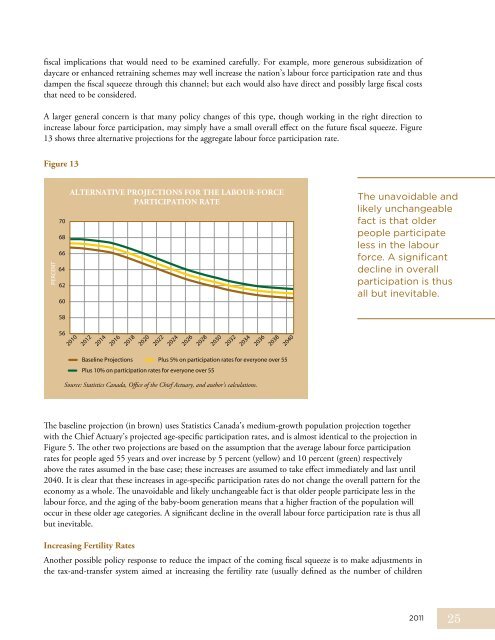Christopher Ragan, "Canada's Looming Fiscal Squeeze," November
Christopher Ragan, "Canada's Looming Fiscal Squeeze," November
Christopher Ragan, "Canada's Looming Fiscal Squeeze," November
You also want an ePaper? Increase the reach of your titles
YUMPU automatically turns print PDFs into web optimized ePapers that Google loves.
fiscal implications that would need to be examined carefully. For example, more generous subsidization of<br />
daycare or enhanced retraining schemes may well increase the nation’s labour force participation rate and thus<br />
dampen the fiscal squeeze through this channel; but each would also have direct and possibly large fiscal costs<br />
that need to be considered.<br />
A larger general concern is that many policy changes of this type, though working in the right direction to<br />
increase labour force participation, may simply have a small overall effect on the future fiscal squeeze. Figure<br />
13 shows three alternative projections for the aggregate labour force participation rate.<br />
Figure 13<br />
PERCENT<br />
70<br />
68<br />
66<br />
64<br />
62<br />
60<br />
58<br />
56<br />
ALTERNATIvE PRoJECTIoNS FoR THE LABouR-FoRCE<br />
PARTICIPATIoN RATE<br />
2010<br />
2012<br />
2014<br />
2016<br />
2018<br />
2020<br />
2022<br />
2024<br />
2026<br />
2028<br />
2030<br />
2032<br />
2034<br />
2036<br />
2038<br />
2040<br />
Baseline Projections Plus 5% on participation rates for everyone over 55<br />
Plus 10% on participation rates for everyone over 55<br />
Source: Statistics Canada, Office of the Chief Actuary, and author’s calculations.<br />
The unavoidable and<br />
likely unchangeable<br />
fact is that older<br />
people participate<br />
less in the labour<br />
force. A significant<br />
decline in overall<br />
participation is thus<br />
all but inevitable.<br />
The baseline projection (in brown) uses Statistics Canada’s medium-growth population projection together<br />
with the Chief Actuary’s projected age-specific participation rates, and is almost identical to the projection in<br />
Figure 5. The other two projections are based on the assumption that the average labour force participation<br />
rates for people aged 55 years and over increase by 5 percent (yellow) and 10 percent (green) respectively<br />
above the rates assumed in the base case; these increases are assumed to take effect immediately and last until<br />
2040. It is clear that these increases in age-specific participation rates do not change the overall pattern for the<br />
economy as a whole. The unavoidable and likely unchangeable fact is that older people participate less in the<br />
labour force, and the aging of the baby-boom generation means that a higher fraction of the population will<br />
occur in these older age categories. A significant decline in the overall labour force participation rate is thus all<br />
but inevitable.<br />
Increasing Fertility Rates<br />
Another possible policy response to reduce the impact of the coming fiscal squeeze is to make adjustments in<br />
the tax-and-transfer system aimed at increasing the fertility rate (usually defined as the number of children<br />
2011<br />
25





